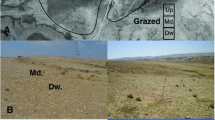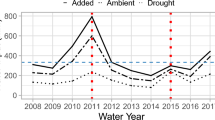Abstract
Studies of rainfall partitioning by shrubs, responses of shrub-dominated ecosystems to herbicide treatment, and experiments using drought and supplemental rainfall were conducted to test the hypothesis that the shrub-dominated ecosystems that have replaced desert grasslands are resistant and resilient to disturbance. Between 16 and 25% of the intercepted rainfall is channelized to deep soil storage by stemflow and root channelization. Stemflow water is nutrient enriched and contributes to the “islands of fertility” that develop under desert shrubs. Drought and rainfall augmentation experiments during the growing season after 5 consecutive years of summer drought found that (1) growth of creosotebushes, Larrea tridentata, was not significantly affected, (2) perennial grasses and forbs disappeared on droughted plots, (3) nitrogen mineralization increased in the short term, and (4) densities and biomass of spring annual plants increased on the droughted plots. Doubling summer rainfall for 5 consecutive years had less-significant effects. Coppice dunes treated with herbicide in 1979 to kill mesquite (Prosopis glandulosa) had the same frequency of occurrence of the shrub as the untreated dunes when remeasured in 1993. These data indicate that the shrub-dominated ecosystems persist because they are resistant and resilient to climatic and anthropogenic stresses.
Similar content being viewed by others
References
Archer, S., C. Scifres, C.R. Bassham and R. Maggio. 1988. Autogenic succession in a subtropical savanna: Conversion of grassland to thorn woodland. Ecological Monographs 58: 111–127.
Buffington, L.C. and C.H. Herbel. 1965. Vegetational changes on a semi-desert grassland range from 1858 to 1963. Ecological Monographs 35: 139–164.
Charley, J.L. and N.E. West. 1975. Plant-induced soil chemical patterns in some shrub-dominated semi-desert ecosystems of Utah. Journal of Ecology 63: 945–964.
Charley, J.L. and N.E. West. 1977. Micro-patterns of nitrogen mineralization activity in soils of some shrub-dominated semi-desert ecosystems of Utah. Soil Biology and Biochemistry 9: 357–365.
Fisher, F.M., L.W. Parker, J.P. Anderson and W.G. Whitford. 1987. Nitrogen mineralization in a desert soil: Interacting effects of soil moisture and nitrogen fertilizer. Soil Science Society of America Journal 51: 1033–1041.
Fisher, F.M. and W.G. Whitford. 1995. Field simulation of wet and dry years in the Chihuahuan Desert: Soil moisture, N mineralization and ion-exchange resin bags. Biology and Fertility of Soils 20: 137–146.
Fisher, F.M., J.C. Zak, G.L. Cunningham and W.G. Whitford. 1988. Water and nitrogen effects on growth and allocation patterns of creosotebush in the northern Chihuahuan Desert. Journal of Range Management 41: 387–391.
Gibbens, R.P. and R.F. Beck. 1987. Increase in number of dominant plants and dominance classes on a grassland in the northern Chihuahuan Desert. Journal of Range Management 40: 136–139.
Glendening, G.E. 1952. Some quantitative data on the increase of mesquite and cactus on desert range in Southern Arizona. Ecology 33: 319–328.
Grover, H.D. and H.B. Musick. 1990. Shrubland encroachment in southern New Mexico, U.S.A.: An analysis of desertification processes in the American southwest. Climatic Change 17: 305–330.
Gutierrez, J.R. and W.G. Whitford. 1987. Chihuahuan Desert annuals: Importance of water and nitrogen. Ecology 68: 2032–2045.
Hennessy, J.T., R.P. Gibbens, J.M. Tromble and M. Cardenas. 1983. Vegetation changes from 1935 to 1980 in mesquite dunelands and former grasslands of southern New Mexico. Journal of Range Management 36: 370–374.
Lajtha, K. and W.H. Schlesinger. 1986. Plant response to variations in nitrogen availability in a desert shrubland community. Biogeochemistry 2: 29–37.
Lajtha, K. and W.G. Whitford. 1989. The effect of water and nitrogen amendments on photosynthesis, leaf demography, and resource-use efficiency in Larrea tridentata, a desert evergreen shrub. Oecologia 80: 341–348.
Martinez-Meza, E. and W.G. Whitford. In press. Stemflow, throughfall, and root water channelization by three Chihuahuan Desert shrubs. Journal of Arid Environments.
Nulsen, R.A., K.J. Bligh, I.N. Baxter, E.J. Solin and D.H. Imrie. 1986. The fate of rainfall in a mallee and heath vegetated catchment in southern Western Australia. Australian Journal of Ecology 11: 361–371.
Parker, L.W., H.G. Fowler, G. Ettershank and W.G. Whitford. 1982. The effects of subterranean termite removal on desert soil nitrogen and ephemeral flora. Journal of Arid Environments 5: 53–59.
Pressland, A.J. 1975. Rainfall partitioning by an arid woodland (Acacia aneura F. Muell.) in southwestern Queensland. Australian Journal of Botany 21: 235–245.
Pressland, A.J. 1976. Soil moisture redistribution as affected by throughfall and stemflow in an arid zone shrub community. Australian Journal of Botany 24: 641–649.
Rappole, J.H., C.E. Russell, J.R. Norwine and T.E. Fulbright. 1986. Anthropogenic pressures and impacts on marginal, neotropical, semiarid ecosystems: The case of south Texas. Science of the Total Environment 55: 91–99.
Reichman, O.J. 1984. Spatial and temporal variation of seed distribution in Sonoran Desert soils. Journal of Biogeography 11: 1–12.
Roundy, B.A. and G.L. Jordan. 1988. Vegetation changes in relation to livestock exclusion and rootplowing in southeastern Arizona. Southwestern Naturalist 33: 425–436.
SAS Institute Inc. 1985. SAS user's guide: statistics, version 5, SAS Institute Inc., Cary, North Carolina.
Virginia, R.A. 1986. Soil development under legume tree canopies. Forest Ecology and Management 16: 69–79.
Virginia, R.A. and W.M. Jarrell. 1983. Soil properties in a mesquite dominated Sonoran Desert ecosystem. Soil Science Society of American Journal 47: 138–144.
Virginia, R.A., W.M. Jarrell, P.W. Rundel, D.H. Kohl and G. Shearer. 1989. The use of variation in the natural abundance of 15N to assess symbiotic nitrogen fixation in woody plants, in P.W. Rundel, J.R. Ehleringer and K. Nagy (Eds.), Stable isotopes in ecological research, Ecological Studies Series Volume 68, Springer-Verlag, Heidelberg and New York, pp. 375–394.
West, N.E. and J.O. Klemmedson. 1978. Structural distribution of nitrogen in desert ecosystems, in N.E. West and J.J. Skujins (Eds.), Nitrogen in desert ecosystems, Dowden, Hutchinson and Ross, Stroudsburg, Pennsylvania, pp. 1–16.
Westoby, M., B. Walker and I. Noy-Meir. 1989. Opportunistic management for rangelands not at equilibrium. Journal of Range Management 42: 266–274.
Whitford, W.G. 1994. Desertification: Implications and limitations of the ecosystem health metaphor, in D. J. Rapport, C. Gaudet and P. Calow (Eds.), Evaluating and monitoring the health of large scale ecosystems, Springer-Verlag, Heidelberg and New York.
Author information
Authors and Affiliations
Additional information
Notice: The U.S. Environmental Protection Agency (EPA), through its Office of Research and Development (ORD), partially funded and collaborated in the research described herein. This paper has been subjected to EPA's peer review and has been approved as an EPA publication. The U.S. Government has a nonexclusive, royalty-free license in and to any copyright covering this article.
Rights and permissions
About this article
Cite this article
Whitford, W.G., Martinez-Turanzas, G. & Martinez-Meza, E. Persistence of desertified ecosystems: Explanations and implications. Environ Monit Assess 37, 319–332 (1995). https://doi.org/10.1007/BF00546898
Issue Date:
DOI: https://doi.org/10.1007/BF00546898




